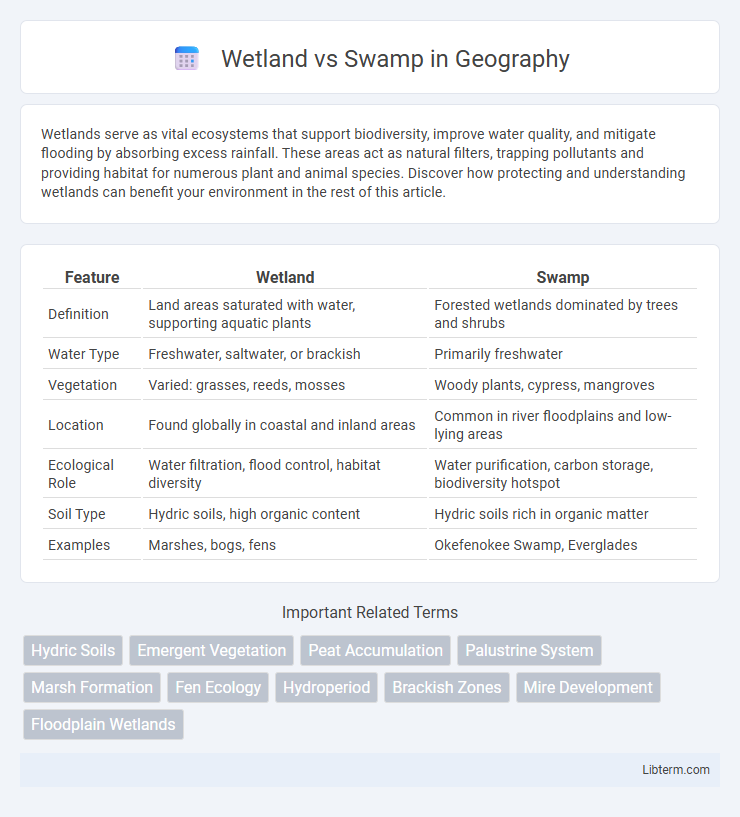Wetlands serve as vital ecosystems that support biodiversity, improve water quality, and mitigate flooding by absorbing excess rainfall. These areas act as natural filters, trapping pollutants and providing habitat for numerous plant and animal species. Discover how protecting and understanding wetlands can benefit your environment in the rest of this article.
Table of Comparison
| Feature | Wetland | Swamp |
|---|---|---|
| Definition | Land areas saturated with water, supporting aquatic plants | Forested wetlands dominated by trees and shrubs |
| Water Type | Freshwater, saltwater, or brackish | Primarily freshwater |
| Vegetation | Varied: grasses, reeds, mosses | Woody plants, cypress, mangroves |
| Location | Found globally in coastal and inland areas | Common in river floodplains and low-lying areas |
| Ecological Role | Water filtration, flood control, habitat diversity | Water purification, carbon storage, biodiversity hotspot |
| Soil Type | Hydric soils, high organic content | Hydric soils rich in organic matter |
| Examples | Marshes, bogs, fens | Okefenokee Swamp, Everglades |
Understanding Wetlands: Definition and Types
Wetlands are areas where water saturates the soil either permanently or seasonally, creating unique ecosystems that support diverse plant and animal species. Types of wetlands include marshes, swamps, bogs, and fens, each characterized by distinct vegetation and hydrology; swamps specifically are wetlands dominated by woody plants like trees and shrubs. Understanding wetlands involves recognizing their role in water filtration, flood control, and habitat provision, highlighting the ecological importance of distinguishing between various wetland types.
What is a Swamp? Key Characteristics Explained
A swamp is a type of wetland characterized by saturated soils and standing water, often dominated by woody plants such as trees and shrubs. Key characteristics include slow-moving or stagnant water, high biodiversity with diverse flora and fauna, and nutrient-rich soils that support dense vegetation. Unlike other wetlands, swamps typically feature forested areas and serve critical roles in flood control, water filtration, and habitat provision.
Wetland vs Swamp: Main Differences
Wetlands are diverse ecosystems characterized by saturated soil conditions and support a variety of plant and animal species, whereas swamps are a specific type of wetland dominated by woody vegetation such as trees and shrubs. Wetlands include marshes, bogs, and fens, featuring a mix of open water and vegetation, while swamps are consistently waterlogged with standing water for much of the year. The primary differences lie in vegetation type, water depth, and hydrology, influencing biodiversity and ecosystem functions.
Ecological Importance of Wetlands
Wetlands play a critical role in maintaining biodiversity, acting as natural filters that improve water quality by trapping pollutants and sediments. They provide essential habitats for countless plant and animal species, supporting complex food webs and contributing to ecosystem stability. Moreover, wetlands act as vital carbon sinks, mitigating climate change by storing significant amounts of carbon dioxide.
Unique Flora and Fauna in Swamps
Swamps are characterized by unique flora such as bald cypress trees and water tupelo, which thrive in their water-saturated, nutrient-rich soils, supporting a diverse ecosystem. Fauna in swamps includes species like alligators, swamp rabbits, and a variety of amphibians and birds adapted to the dense vegetation and standing water environment. These distinct plant and animal communities differentiate swamps from other wetlands by creating complex habitats crucial for biodiversity and ecological balance.
Hydrology: Water Sources in Wetlands and Swamps
Wetlands receive water from various sources, including precipitation, surface water runoff, groundwater seepage, and tidal flows, creating diverse hydrological conditions that support rich ecosystems. Swamps are a type of wetland characterized by standing or slow-moving water primarily sustained by surface water and intermittent flooding, often from rivers or lakes. The hydrology of swamps features prolonged saturation and higher water depth compared to other wetlands, influencing plant and animal species adapted to these wetter conditions.
Human Impacts on Wetlands vs Swamps
Human activities such as urban development and agriculture significantly alter wetlands by draining water, leading to habitat loss and reduced biodiversity. Swamps often face deforestation and water pollution due to nearby industrial operations, disrupting their complex ecosystems. Both wetlands and swamps serve vital roles in flood control and water filtration, making their preservation crucial amidst growing anthropogenic pressures.
Conservation Strategies for Wetlands and Swamps
Conservation strategies for wetlands and swamps emphasize protecting biodiversity, maintaining water quality, and preventing habitat loss through policies like wetland restoration, controlled water management, and pollution reduction. Implementing buffer zones, restrictive land-use regulations, and community engagement programs enhances ecosystem resilience and supports native species conservation. Effective monitoring and adaptive management practices ensure long-term sustainability of these critical habitats amid climate change and urban development pressures.
Wetland and Swamp Functions in Climate Regulation
Wetlands act as crucial carbon sinks, absorbing large amounts of carbon dioxide and mitigating climate change by storing organic carbon in water-saturated soils. Swamps, a type of wetland dominated by woody vegetation, also contribute to climate regulation by maintaining hydrological balance and supporting biodiversity that enhances ecosystem resilience. Both wetlands and swamps regulate local temperatures through evapotranspiration, reducing heat extremes and stabilizing microclimates.
Frequently Asked Questions: Wetland vs Swamp
Wetlands are ecosystems characterized by saturated soil and diverse plant life including grasses and shrubs, while swamps are a specific type of wetland dominated by trees and woody vegetation. Frequently asked questions often address differences in biodiversity, with swamps supporting species adapted to forested, waterlogged conditions and wetlands hosting a broader range of aquatic and semi-aquatic organisms. Another common inquiry involves their ecological roles, where wetlands serve critical functions in water filtration and flood control, and swamps provide essential habitats for wildlife and carbon storage.
Wetland Infographic

 libterm.com
libterm.com